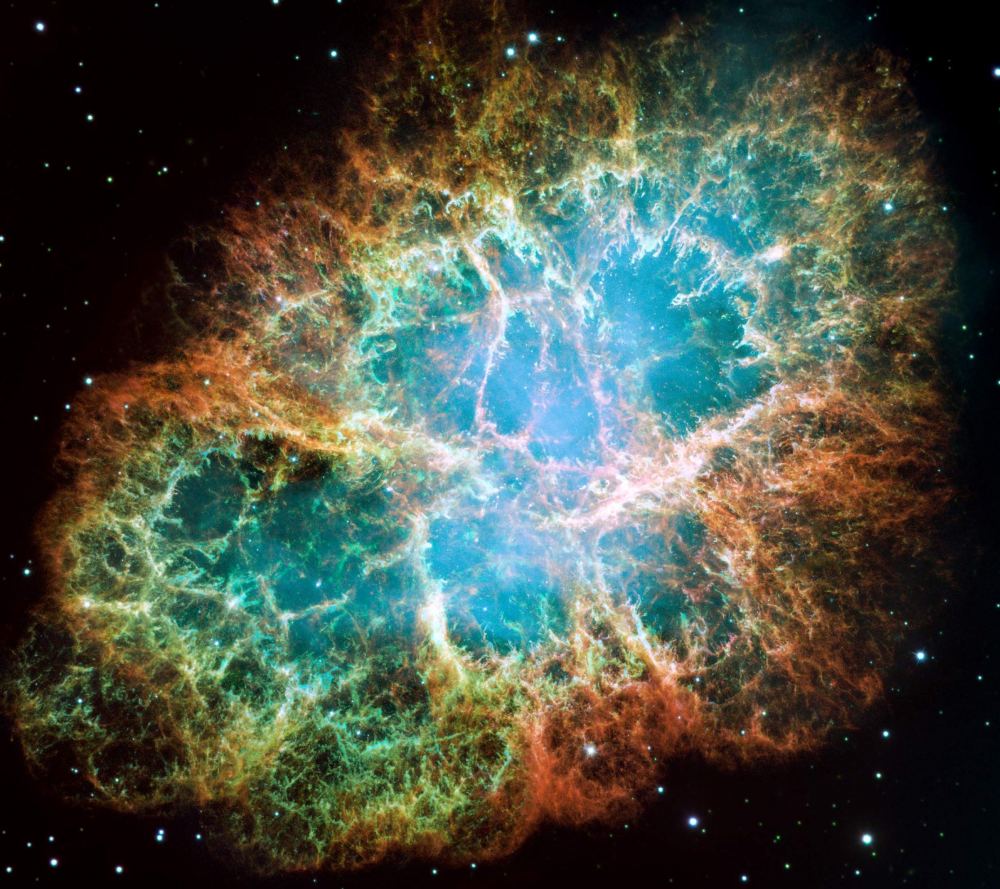The Crab Nebula, or M1 (the first object in Messier’s famous catalog), is a supernova remnant and pulsar wind nebula. The name – Crab Nebula – is due to the Earl of Rosse, who thought it looked like a crab; it’s not in the constellation Cancer (the Crab), rather Taurus (the Bull).
The supernova which gave rise to the Crab Nebula was seen widely here on Earth in 1054 (and so it’s called SN 1054 by astronomers); it is perhaps the most famous of the historical supernovae. It is certainly one of the brightest (estimated to be –7 at peak), partly because it is so close (only 6,300 light-years away), and partly because it’s not hidden by dust clouds. The expansion of the nebula – as in seen-to-be-getting-bigger, rather than the-gas-is-moving-very-fast – was first confirmed in 1930.
As it was a core collapse supernova (a massive star which ran out of fuel), it left behind a neutron star; by chance, we are in line with its ‘lighthouse beam’, so we see it as a pulsar (all young neutron stars are pulsars, but not all of them have beams which point to us in one part of the cycle). It’s a pretty fast pulsar; the neutron star rotates once every 33 milliseconds. Because it’s so young and so close, the Crab Nebula pulsar was the first to be detected in the visual waveband, and also in x-rays and gamma rays. Being the source of the tremendous output of energy, from both the pulsar wind nebula and the pulsar itself, and as energy is conserved, the pulsar is slowing down, at a rate of 15 microseconds per year.
The inner part of the Crab Nebula, the pulsar wind nebula, contains lots of really hot (‘relativistic’) electrons spiraling around magnetic fields; this creates the eerie blue glow … synchrotron radiation. This makes the Crab Nebula one of the brightest objects in the x-ray and gamma ray region of the electromagnetic spectrum, and as it is a relatively steady source (unlike most high energy objects) it has given its name to a new astronomical unit, the Crab. For example, a new x-ray source may be 2 mCrab (milli-Crab), meaning 0.002 times as strong an x-ray source as the Crab Nebula.
This SEDS page has a lot more information on the Crab Nebula, both historical and contemporary.
Such an intensively studied object, no wonder there are lots of Universe Today stories on it; for example Nearly a Thousand Years After the Death of a Star, Giant Hubble Mosaic of the Crab Nebula, The Peculiar Pulsar in the Crab Nebula, Astronomers Locate High Energy Emissions from the Crab Nebula, and Evidence of Supernovae Found in Ice Core Sample.
Astronomy Cast’s Neutron Stars and Their Exotic Cousins has more on pulsars, and Nebulae more on nebulae.
Sources: Caltech Astronomy, SEDS, Stanford University SLAC

